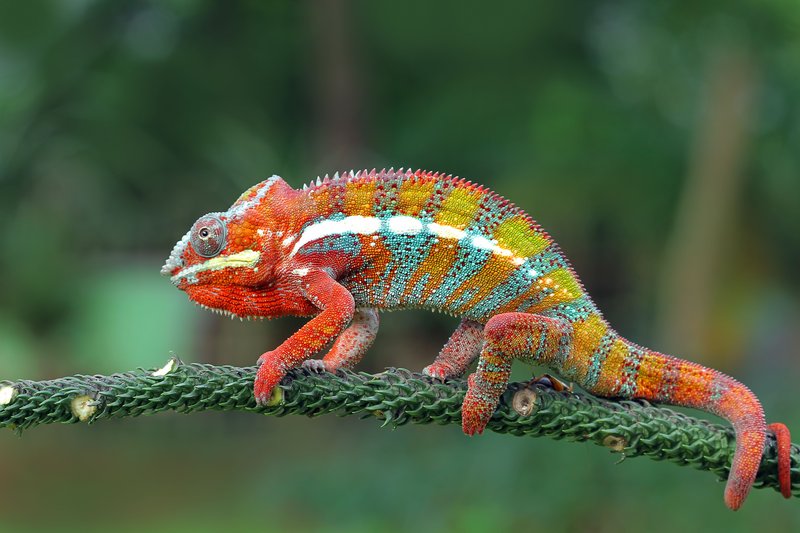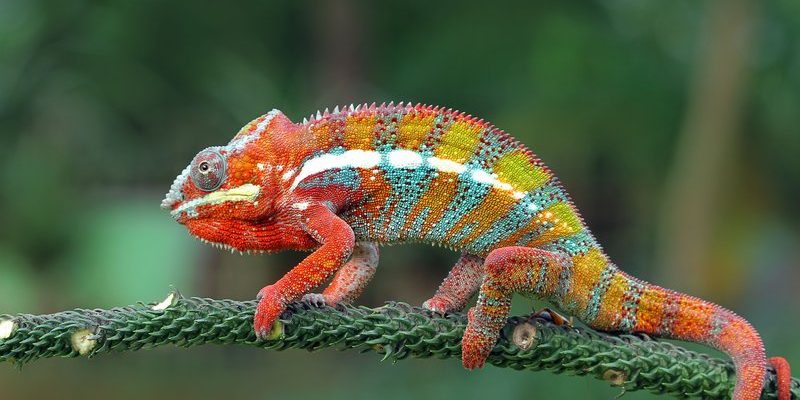
Living in hot, dry climates like deserts and savannas, chameleons face challenges such as extreme temperatures and scarce food sources. You might be wondering how they manage to stay alive under such conditions. Well, let’s dive into the incredible world of chameleons and uncover the secrets of their survival.
Color Change: More Than Just a Party Trick
One of the most well-known features of chameleons is their ability to change color. This isn’t just for show; it plays a crucial role in their survival. When they change colors, they can regulate their body temperature. Think of it like wearing a light shirt on a hot day versus a dark one. Lighter colors reflect sunlight, helping to cool them down.
But color change also helps chameleons communicate with each other. When threatened, a chameleon might turn darker to signal stress or aggression, while brighter colors can indicate readiness to mate. This adaptability shows how chameleons don’t just change for fun; they do it to navigate their social interactions and environmental challenges.
Temperature Regulation
Chameleons often inhabit areas with scorching heat. When the sun blazes down, they can shift to lighter shades to reflect sunlight and avoid overheating. Conversely, when temperatures cool off, they might darken to absorb more warmth. This clever strategy is crucial for their survival, as maintaining the right body temperature helps them stay active and hunt for food.
Camouflage for Protection
Additionally, blending into their environment is essential for avoiding predators. By altering their colors to match leaves, branches, or rocks, chameleons can become nearly invisible. This skill is a double-edged sword, as it protects them from predators while also allowing them to stalk their prey without being noticed.
Extreme Hydration Techniques
In many harsh environments, water can be scarce, making hydration a major concern for chameleons. Unlike some animals that can drink from standing water, chameleons have smarter tactics. They often rely on dew and rain, drinking droplets that collect on leaves in the early mornings.
Here’s the thing: chameleons also have a unique ability to absorb moisture through their skin. This means that even if they’re not drinking directly, they can still get hydration from the humidity in the air. It’s like sipping on a refreshing drink without a glass!
Creating Water Resources
In areas where water is especially rare, some chameleons have adapted to live in places where they can catch moisture more efficiently. They often take advantage of mist or light rainfall by positioning themselves in the right spots to collect the most moisture. This strategic thinking allows them to get the hydration they need without wandering too far from their territory.
Specialized Nasal Structures
Chameleons also have specialized nasal passages that help them conserve water. These adaptations allow them to filter moisture from the air and save it, reducing their need for direct water sources. In essence, they have turned their noses into efficient hydration systems!
Effective Foraging Strategies
Finding food in harsh environments can be tough. Chameleons are primarily insectivores, meaning they mostly eat insects like crickets, grasshoppers, and flies. In an environment where food is limited, they’ve developed some ingenious strategies for foraging.
One of their key tactics is their incredible vision. Chameleons have very mobile eyes that can move independently, allowing them to spot food without moving their bodies. Imagine having a drone-like capability to scope out your snacks from all angles! With exceptional depth perception, they can accurately judge distance and strike prey with their long, sticky tongues.
Energy Conservation
Energy conservation is another critical aspect of their foraging strategy. Chameleons tend to be slow-moving, which helps them avoid detection by both predators and potential prey. They often sit still for long periods, waiting patiently for the perfect moment to strike. This slow and steady approach not only conserves energy but also increases their chances of a successful catch.
Adapting to Food Availability
Some chameleons can adjust their diets based on the resources available in their habitat. If certain insects are plentiful, they might focus on those. This flexibility helps them survive when their usual meals are scarce. It’s a bit like how we try to eat what’s available, even if it’s not our favorite dish!
Habitat Selection: Finding the Right Spot
Choosing the right habitat is essential for chameleons. They often prefer regions with plenty of vegetation, which provides both food and cover. In harsh environments, they look for areas that offer shade and protection from extreme weather.
Chameleons tend to favor trees and shrubs, which give them access to sunlight for basking and places to hide from predators. These spots are like their personal sanctuaries, providing everything they need to thrive in tough conditions.
Vertical Climbing
Their climbing abilities also play a role in their survival. By moving higher up into trees, chameleons can escape ground-dwelling predators while enjoying more abundant food sources. It’s similar to how we might choose a higher vantage point to avoid danger or survey our surroundings.
Microhabitats
Chameleons are masters at exploiting microhabitats. These smaller environments within a larger ecosystem can vary significantly in temperature and humidity. By strategically moving between these areas, chameleons can optimize their conditions based on their immediate needs for food, hydration, or warmth.
Overcoming Stress and Predation
Survival in harsh environments isn’t just about finding food and water; it also involves managing stress and avoiding predators. Chameleons face threats from various sources, including birds and snakes. To mitigate these dangers, they employ a combination of tactics.
When a predator approaches, a chameleon might freeze or change color to blend in. It’s a bit like playing hide-and-seek where they try to become invisible to their opponent. If spotted, they often dart away, relying on their quick movements to escape.
Stress Response
Chameleons also have a unique stress response. When they feel threatened, their bodies release hormones that can help them react quickly. However, chronic stress can negatively impact their health, making it vital for them to find safe places to rest and recover.
Behavioral Adaptations
Some species have behavioral adaptations that further aid their survival. For instance, they may become more nocturnal to avoid daytime predators. By shifting their activity patterns, they increase their chances of staying alive in environments where danger lurks around every corner.
Chameleons have a rich tapestry of survival strategies that allow them to thrive in harsh environments. From their stunning ability to change colors and regulate temperature to their smart foraging techniques and habitat selection, these creatures truly embody resilience.
Whether they’re sipping dew from leaves or cleverly avoiding predators, chameleons remind us that adaptability is key to survival in the wild. Just like them, we can learn to adapt to our environments and find ways to thrive, no matter the challenges we face. Nature’s wonders, like the chameleon, continue to inspire us with their incredible ability to survive and flourish against the odds.

